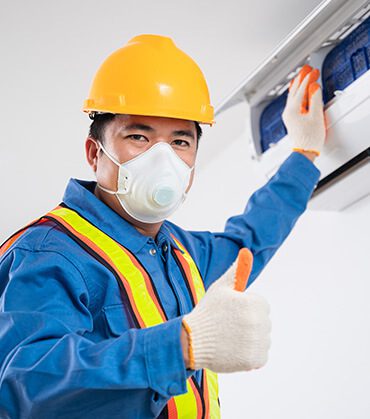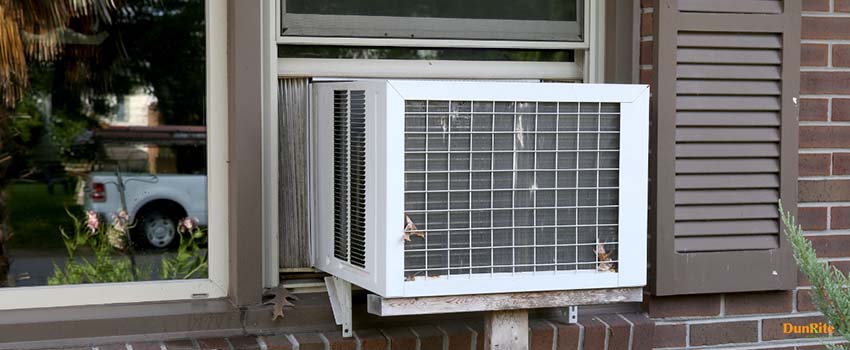Air conditioners are pretty much left unused during fall and winter. During this time, the insides of your air conditioning unit, which will be damp, dirty, and dark, will provide the perfect environment for mold to proliferate. It is why the moment you turn on your AC after not being used for a long time, you’d smell something off, like something musty or damp—that’s molds in the air conditioner you smell right there.
What Causes Mold in an Air Conditioner?
Mold spores are constantly around us, flying in the air. Yes, even inside our homes. Many of them will land somewhere that’s dry and just die. However, a lot of them will find a wet or damp surface and multiply. This is why you’d find mold growths in plumbing and roof leaks that’s been disregarded or overlooked.
As mentioned earlier, the insides of an unused air conditioner will often be dirty and damp, a perfect environment for molds to grow. Once they have settled nicely inside the AC, these spores will begin reproducing, eventually releasing more of their kind and becoming airborne. These can spread throughout your house, landing on food, clothing, and other items.
If left unattended, molds can reduce the effectiveness of your air conditioner. Depending on the types of mold in the air ducts, the fungi can block the unit drains and other system parts. This can lead to a machine breakdown which may require extensive repairs.
Is Mold in the AC Unit Dangerous?
The straight answer to this question is a resounding yes. Aside from the possibility of your air conditioning unit breaking down, the spores that will blow out and spread inside your home can cause a lot of potential health problems. Although it’s unlikely that you have black mold in the air conditioner, spores can produce allergens, which can cause headaches, sore throats, and various respiratory ailments. These spores can even become deadly if you or a family member has allergies or asthma.
Air Conditioner Mold Removal Steps
Molds are unwelcome guests in our homes. If you notice any signs of these fungi in your unit, it’s best to take out your cleaning equipment.
While an HVAC professional should handle more severe cases, you can easily get rid of this problem by following the step-by-step guide provided below:
1. Shutoff the AC
The air conditioning system should be turned off to prevent the spread of unhealthy air due to mold infestation. This is the basic recommendation of the Environmental Protection Agency when it comes to molds in the air conditioner.
2. Wear Protective Gear
The face, especially your eyes, is most vulnerable when dealing with molds. Shield them from danger by wearing protective eyewear and a mask. Non-porous gloves should also be worn for your hands. All of these can be purchased at your local hardware shop if you don’t already have them.
3. Check for Molds
To determine the extent of mold damage, take a close look at the overall appearance of your air conditioner. A mold problem can be identified by visible dark spots and white fuzzy growths in various areas. Even if you don’t see physical mold presence, if you notice a strange smell when turning on the AC, it means some sort of contamination has occurred.
4. Prepare Cleaning Solution
To remove molds in the air conditioner, you can use household multipurpose cleaning products, but you can also consider bleach or distilled vinegar. Another option is to buy a registered mold removal product recommended by the Environmental Protection Agency, usually available at your local hardware shop. When settling for this option, you should aim for a 1:3 ratio of the cleaning mixture and hot or warm water.
5. Remove AC Parts
AC units are different in how they are assembled, so check your owner’s manual to find out how to identify and remove the exterior grille cover to access the interior. Although the cover can be removed easily, as most models snap off, some are held in position by screws, which a screwdriver can easily remove.
Use a flashlight to check the interior of your air conditioner for signs of mold growth. These may include streaks or clusters of black, brownish, or greenish stains. Some may also appear fuzzy or powdery. If you see only small traces, cleaning the unit can commence.
6. Vacuum the AC
Use a vacuum to remove dust and debris from your air conditioner. To eliminate as much dirt as possible, use a nozzle attachment. Afterward, spray the U-shaped coils located at the front and back end of your AC using a commercial coil cleaner. Let the solution sit for a few hours to dissolve any residue. Finish this up by washing off the cleaning solution with a garden hose.
7. Scrub and Rinse
Use a sponge and a mixture of warm water and your cleaning solution to scrub the inside of your air conditioning unit thoroughly. Alternatively, a gallon of warm water can be mixed with half a cup of household bleach and placed in a plastic bucket. The mixture should kill all existing mold spores if a colony has not been established yet. However, if the mold is persistent, call a professional to remove it.
Let your cleaning solution sit on your unit for about 10 minutes. Spray this off later using clean water and wiping the area clean with a piece of dry cloth.
8. Dry the AC
Allowing your air conditioner to dry completely can take 24 hours, as this should include the grille cover, the filter, and all the other parts. Once this is achieved, turn the unit on for a test run.
9. Re-Install Unit Parts
After your AC has dried completely, place all the parts back and turn the unit on again. Molds may still be present in the machine if you notice an unusually strong odor or if you experience sudden allergic reactions. If this happens, it’s best to contact a specialist.
Key Takeaway
How to tell if your AC has mold can be rather tricky. Often, this could require excellent working knowledge of the anatomy and function of the unit. Also, because there’s the risk of electrocution and injury, some parts of your AC where molds could form should not be accessed except by a trained and licensed air conditioning specialist.
Yet, you must prevent mold from forming in your air conditioning system, especially if you’re dealing with the black mold type. A black mold in the air conditioner can be difficult to remove and is also dangerous. This needs to be referred to professional cleaning service companies.
When it comes to air conditioning system issues, DunRite Heating & Air, Inc is your best bet.
We at DunRite Heating & Air, Inc. understand just how important air conditioners are for every household. If you’re having problems with your unit’s performance, feel free to contact us anytime.
We have a team of experts that offer top-notch HVAC repair in San Jose. We can take a look into your case, as this could be due to mold. Rest assured that your AC problem will be resolved to your satisfaction. Call us now.



